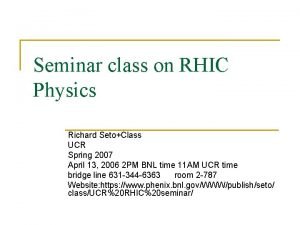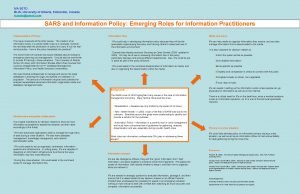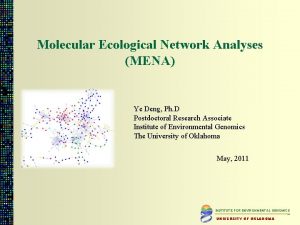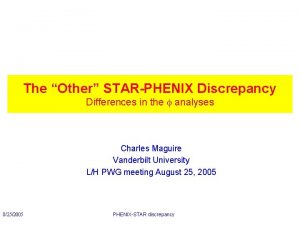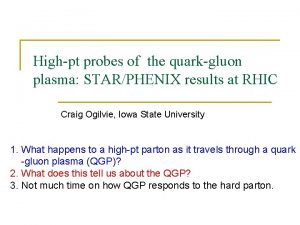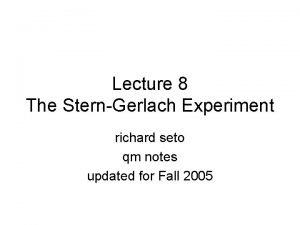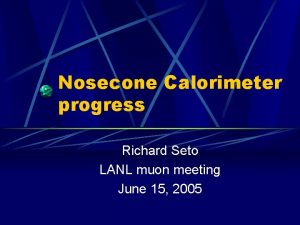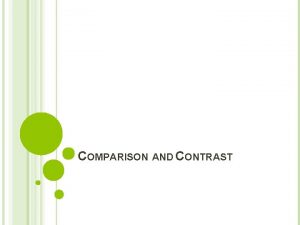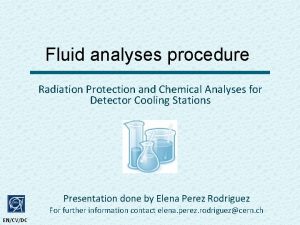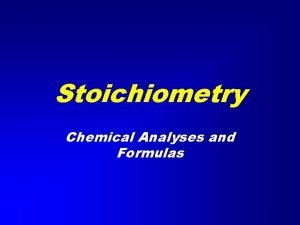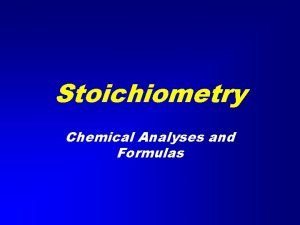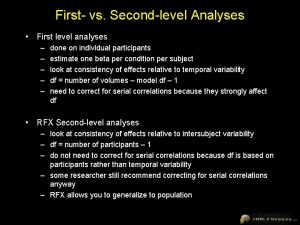STARPHENIX Comparison Differences in the analyses Richard Seto















- Slides: 15

STAR-PHENIX Comparison Differences in the analyses Richard Seto Collected slides from Charlie, dipali etc

p-p @ 200 Ge. V 9/30/2020 pp comparison 2

Min Bias d + Au @ 200 Ge. V d. Au min bias comparison 9/30/2020 3

d. Au 9/30/2020 d. Au comparison 4

Au-Au data Au. Au comp arison 9/30/2020 5

comments • Au. Au – PP same – Au. Au star higher than phenix – all centralities – HENCE • Rcp should be same in both exps – it is • R_AA will be different - phenix suppressed Star not (this is what is seen) – When does hard scattering come in? • d. A – pp same – d. Au • Central: star slightly higher than phenix. • peripheral- nominal agreement – HENCE • Rcp different in the two experiments with phenix showing suppression • Rd. A different in two experiments with phenix showing suppression • STAR shows no suppression in both (IS THIS TRUE? ) – Rd. Au phenix is shows “suppression!!!? ” 9/30/2020 6

More comments • PHENIX higher than STAR in ALL AU-AU and Central d. Au • PHENIX and STAR “agree” in pp and peripheral d. Au • PHENIX lower than star on high multiplcity events – Multiplcity dependent problem? – Embedding or efficiency? ? 9/30/2020 7

d. Au 9/30/2020 8

AU-Au Current Status of the Run 2 Discrepancy Looking at the integrated yield numbers d. N/dy • Publications from Run 2 Au+Au data at 200 Ge. V – STAR in PL B 612 (April 2005) 181 -189 – PHENIX in PR C 72 (July 2005) 014903 • One common centrality bin and minimum bias data can be directly compared using exponential fitting Centrality STAR d. N/dy PHENIX d. N/dy STAR T PHENIX T 0 - 10% 6. 65 +/- 0. 35 +/- 0. 73 3. 94 +/- 0. 60 +/- 0. 62 357 +/- 14 +/- 39 376 +/- 24 +/- 20 Mininum Bias 2. 40 +/- 0. 07 +/- 0. 26 1. 34 +/- 0. 09 +/- 0. 21 353 +/- 9 +/- 39 366 +/- 11 +/- 18 Run 2 discrepancy factors for d. N/dy 1. 69 +/- 0. 27 (0 - 10% centrality) 1. 79 +/- 0. 13 (minimum bias) 9/30/2020 statistical errors only 9

Update from QM’ 05 Presentations • Both STAR and PHENIX presented Run 4 yield results – Both stated that their Run 4 results agreed with their Run 2 results By inference the integrated yield discrepancy persists for Run 4 – Questions were asked about the STAR-PHENIX discrepancy Obvious interest in getting this discrepancy resolved – STAR had a back-up slide not shown quoting a Rafelski et al. preprint which questioned the lowest PHENIX m. T data point in 0 -10% centrality (that back-up slide will be shown later in this presentation) • STAR and PHENIX presented the first v 2 results for the – STAR’s result tended to be higher than PHENIX’s result but the error bars are too large to conclude that there is a discrepancy – The yield discrepancy may diminish the credence of the v 2 quotes ? • PHENIX declined to show Rd. Au results for the • STAR declined to show Run 4 RAA results for the but PHENIX did show Run 4 RAA results claiming suppression – In its Run 2 paper STAR had shown an absence of suppression for the 9/30/2020 10

RAA and RCP From Run 2 STAR (PLB figure) STAR sees almost the same RCP ~0. 5 for the as PHENIX in the Run 2 data STAR sees no RAA suppression for the in the 0 -5% centrality bin from Run 2 for the p. T range 1. 5 to 3. 4 Ge. V/c STAR sees RAA ~1. 5 enhancement for the in the 60 -80% centrality bin for the p. T range 1. 5 to 3. 4 Ge. V/c 9/30/2020 11

RAA and RCP from Run 4 PHENIX (QM’ 05 prelim figures) PHENIX claims RAA ~0. 4 suppression for the in the 0 -10% centrality bin for the p. T range 1. 5 to 2. 1 Ge. V/c comparable to effect seen in the p 0 Suppression decreases in the 60 -90% bin, again comparable to the p 0 RCP for the comparable to what STAR has published for Run 2 9/30/2020 12

Update on RCP 2. 5 Ratio 2. 0 1. 5 Rd. Au RAA(60~80/pp) RAA(05/pp) 1. 0 0. 5 STAR Preliminary Talk by Xiangzhou Cai 0. 0 0. 5 1. 0 1. 5 2. 0 2. 5 3. 0 3. 5 4. 0 PT (Ge. V/c 2 ) PHENIX Preliminary: Talk by D. Pal The RCP is well below proton or lambda RCP. Consistent with NCQ scaling expectations. a discrepancy arises between PHENIX and STAR RAA (RAA ≠ RCP) 9/30/2020 13

Question about Rd. Au for the in PHENIX Values appear to be systematically low? 9/30/2020 14

Unshown STAR Backup Slide from QM’ 05 (but it shows what they are thinking) Johann Rafelski etc. nucl-th/0412072 0 - 10% centrality STAR data 0 - 10% centrality PHENIX data 0 - 10% centrality STAR and PHENIX 9/30/2020 Rafelski et al. conjecture that the lowest PHENIX m. T data point is a factor of 1. 5 too low and this drives the low d. N/dy value for PHENIX. Since STAR has more low m. T data, then STAR’s result is more believable My opinion (see next slide): By using a linear plot Rafelski et al. obscure the difference in normalization at the higher m. T points. Rafelski et al. also ignore the minimum bias data discrepancy. 15
 Richard seto ucr
Richard seto ucr Arnold seto
Arnold seto Arnold seto md
Arnold seto md Mlis university of alberta
Mlis university of alberta Seto kongress
Seto kongress Critical thinking in nursing process
Critical thinking in nursing process Rhetorical choices
Rhetorical choices Geicp
Geicp Concln
Concln Looking for richard analysis
Looking for richard analysis Limit comparison theorem
Limit comparison theorem Phản ứng thế ankan
Phản ứng thế ankan Các môn thể thao bắt đầu bằng từ đua
Các môn thể thao bắt đầu bằng từ đua Sự nuôi và dạy con của hươu
Sự nuôi và dạy con của hươu điện thế nghỉ
điện thế nghỉ Biện pháp chống mỏi cơ
Biện pháp chống mỏi cơ
